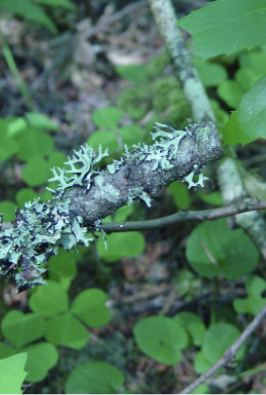Lichens
Guilt by association: This often is the plight of lichens in the landscape. Lichens are crusty growths that may be found on just about any outdoor surface, from tombstones and rocks to the bark of woody plants. Lichens are often unnoticed or ignored until a tree or shrub begins to decline. Lichens are colorful and can be unusual looking, drawing attention to a declining plant and leading people to mistakenly infer that lichens caused the plant’s demise. The truth is that lichens are harmless to plants.
Lichens take many forms (Figure 1), which may cause them to be mistaken for plants or for fungi such as mushrooms and molds. Lichens actually are formed by the marriage of an organism that can make its own food through photosynthesis and a fungus. The photosynthetic organism is usually an alga or sometimes a cyanobacterium. The two organisms live as one, each depending on the other for survival.
The roles of the partnership are complex, but, in general, the fungus provides protection and moisture, allowing the photosynthetic partner to survive in drier places than it could on its own.
Fungi cannot make their own food, so they absorb some of the food made by their partner. Thus, the fungus provides shelter and water, and the alga or cyanobacterium provides food. Together, they form a lichen. Because lichens make their own food, they do not form a harmful, parasitic relationship with plants.
While lichens themselves do not harm plants, they may indicate that a plant is under stress. Trees that are declining generally have smaller and fewer leaves than normal, allowing more sunlight to reach the trunk and branches. Lichens take advantage of the increased light and become more abundant on the bark. For this reason, many people mistakenly believe that lichens are killing the plant. Actually, lichens are just using the bark as a place to sit and take advantage of the sunlight that they use to make their own food.
Lichens can act as a “canary in a coal mine.” Heavy lichen growth on a tree or shrub may indicate that the plant is under stress from things like disease, insects, environmental conditions, or cultural problems.
Chemical control of lichens on plants is not typically recommended. However, if lichen growth is undesirable, then products containing potassium salts of fatty acids may be applied according to label directions. Examples of labeled products registered for use in Mississippi include Scotts Moss EX 3-in-1 Ready-Spray, Bonide MossMax Ready to Spray, Safer Brand Moss & Algae Killer and Surface Cleaner, and BioAdvanced 2-in-1 Moss and Algae Killer and Cleaner Ready to Spray. These products control lichens on the bark of ornamental trees as well as hard surfaces in the landscape, like sidewalks or structures.




Figure 1. Lichens come in many forms and colors. Fruiticose lichens have a shrubby appearance (1a); foliose lichens are layered and leafy looking (1b); crustose lichens form a flat crust on the bark surface(1c); old man’s beard (Usnea sp.) is a hair-like lichen common in the Pacific Northwest (1d).
The information given here is for educational purposes only. References to commercial products, trade names, or suppliers are made with the understanding that no endorsement is implied and that no discrimination against other products or suppliers is intended.
Publication 2946 (POD-05-22)
By Clarissa Balbalian, Diagnostic Lab Manager, Biochemistry, Molecular Biology, Entomology, and Plant Pathology.
The Mississippi State University Extension Service is working to ensure all web content is accessible to all users. If you need assistance accessing any of our content, please email the webteam or call 662-325-2262.




